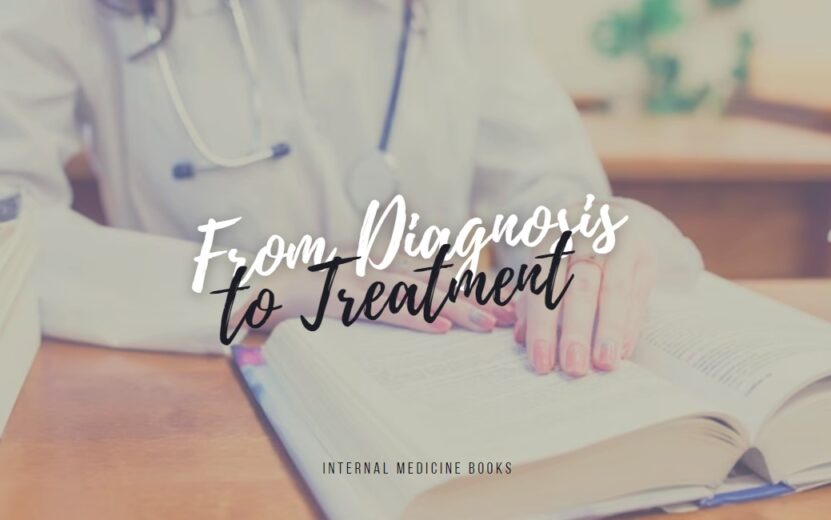Aspiring physicians who want to specialize in Internal Medicine require a strong foundation of knowledge to prepare them for clinical practice. Internal medicine textbooks provide a comprehensive overview of the subject matter that is essential for medical students, residents, and fellows.
These textbooks cover the fundamentals of the field, including physiology, pharmacology, epidemiology, and clinical decision-making. In this blog post, we will discuss some of the best Internal Medicine textbooks available today.
List of Books
1. “Harrison’s Principles of Internal Medicine”
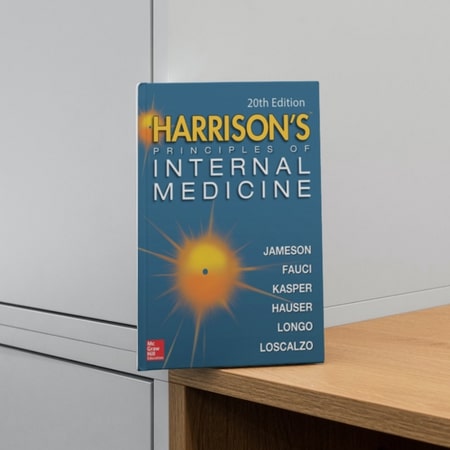
Harrison’s Principles of Internal Medicine is a landmark guide that has been trusted by healthcare professionals worldwide for over 70 years. It is widely recognized as the leading authority on applied pathophysiology and clinical medicine, providing comprehensive, accurate, and essential coverage of the pathogenesis, diagnosis, and treatment of disease.
Written and edited by the world’s top experts in their respective fields, this text is a superb resource for learning the art and science of clinical reasoning.
One of the strengths of Harrison’s is its clear and concise schemas, which facilitate the generation of differential diagnoses and reasoning efficiently through complex real-world clinical cases.
The physiologic and etiologic basis of signs and symptoms is covered through a wealth of unsurpassed expert guidance and linked to disease-specific chapters that follow. The textbook also features updated clinical trial results and recommended guidelines, excellent and extensive visual support, practical clinical decision trees and algorithms, and coverage of both therapeutic approaches and specific treatment regimens.
With its organ/system-specific sections, clinically relevant pathophysiology, and practical clinical advice on the approach to the patient, Harrison’s is a comprehensive and indispensable resource for medical professionals at all levels of training and experience.
The 21st edition of Harrison’s Principles of Internal Medicine features the most timely and comprehensive updates from the world’s top experts. Current coverage of the diagnosis and treatment of diseases, including COVID, dementia, sepsis, multiple sclerosis, and lung cancer, reflects newly approved therapeutics and new practice-changing guidelines and evidence summaries.
With over 1000 clinical, pathological, and radiographic photographs, diagnostic and therapeutic decision trees, and clear schematics and diagrams describing pathophysiologic processes, the textbook is a visually stunning resource.
Numerous atlases featuring curated collections of important visual aspects of diagnosis and management, along with updated and time-saving curation and synthesis of established and new medical literature and studies, make Harrison’s Principles of Internal Medicine an essential tool for medical professionals in the fast-paced and ever-changing field of internal medicine.
2. “Cecil Essentials of Medicine”
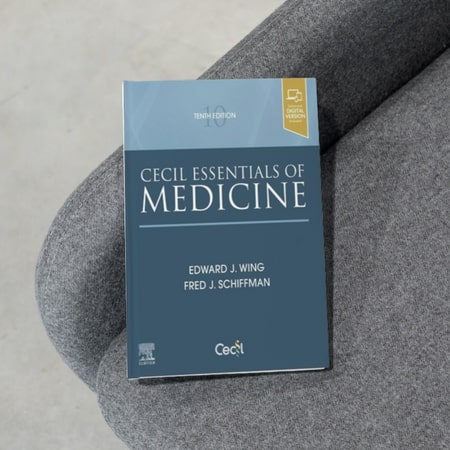
Cecil Essentials of Medicine has been a favorite of students, residents, and instructors through nine outstanding editions. Known for its concise, easy-to-read writing style and comprehensive coverage, this revised 10th Edition continues the tradition of excellence with a focus on high-yield core knowledge of key importance to anyone entering or established in the field of internal medicine.
Edited by Edward J. Wing and Fred J. Schiffman, along with other leading teachers and experts in the field, Cecil Essentials remains clinically focused and solidly grounded in basic science.
The 10th edition of this book has a new focus on high-yield, core knowledge necessary for clerkships or residencies in medicine, with concise, complete coverage of the core principles of medicine and how they apply to patient care.
Each section describes key physiology and biochemistry, followed by comprehensive accounts of the diseases of the organ system or field covered in the chapters. The full-color design enhances the readability and retention of concepts, while numerous imaging videos cover cardiovascular disease, endoscopy, sphincterotomy, and more.
Superb images and photographs vividly illustrate the appearance and clinical features of the disease, making it an essential resource for medical students, residents, and practicing physicians.
New chapters in the 10th edition cover Women’s Cancer and Transitions in Care from Children to Adults with Pulmonary Disease, reflecting the latest advances and changes in the field of internal medicine.
The book also features Student Consult features, which include web-only extras, additional figures and tables, clinical photos, radiologic images, video procedures, imaging studies, and audio recordings.
An enhanced eBook version is included with the purchase, allowing readers to access all of the text, figures, and references from the book on a variety of devices. With its comprehensive coverage, clinically focused approach, and high-yield core knowledge, Cecil Essentials of Medicine is an indispensable resource for medical students, residents, and practicing physicians alike.
3. “The Washington Manual of Medical Therapeutics”
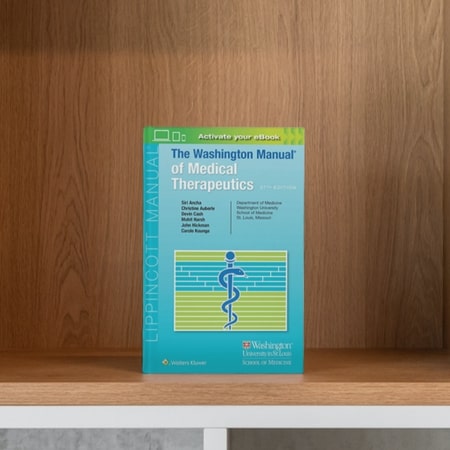
The Washington Manual® of Medical Therapeutics, 37th Edition, is an essential resource for successful patient care, with concise, high-yield content that reflects the fast-changing advances in medical technology and therapeutics.
Written by faculty, residents, and fellows and edited by chief residents of the distinguished Washington University School of Medicine in St. Louis, the Washington Manual provides brief, logical approaches to diagnosis and management of commonly encountered medical conditions, including new therapies that improve patient outcomes.
This best-selling resource is depended on by house staff and faculty around the world for day-to-day clinical practice in internal medicine.
The Washington Manual provides comprehensive coverage of many areas of medicine and the core subspecialties, all at your fingertips for quick review and reference. It features a new, colorful presentation with easy-to-follow guidelines, tables, diagrams, and dosing and treatment information.
The book includes easy-to-use algorithms for fast visual guidance and addresses challenges that residents, interns, medical students, and other practitioners confront every day. The content is carefully edited by Internal Medicine Chief Residents from the Washington University School of Medicine and Barnes-Jewish Hospital in St. Louis, ensuring that it reflects the latest evidence-based medicine and practical approaches to patient care.
The Washington Manual® is a registered mark belonging to Washington University in St. Louis, to which international legal protection applies, and is used in this publication by Wolters Kluwer Health under license from Washington University.
With its concise, high-yield content and practical approach to patient care, the Washington Manual is an indispensable resource for medical professionals at all levels of training and experience.
4. “Current Medical Diagnosis and Treatment”
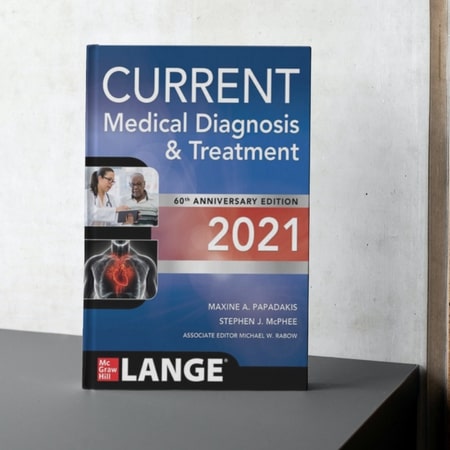
For 60+ years, CURRENT Medical Diagnosis & Treatment has been the go-to guide for students, residents, and clinicians who need authoritative information to build their medical knowledge, expertise, and confidence.
This updated edition of the flagship title of the LANGE medical book brand presents the most important diagnostic and treatment recommendations, as well as the most useful new clinical developments in every field of adult medicine. Written by top experts in their fields, this unmatched guide enables readers to find the answers they need quickly and easily.
This book provides coverage of more than 1,000 diseases and disorders, with a comprehensive approach to patient care that focuses on diagnostic tools for day-to-day practice. It features hundreds of drug treatment tables for quick access to indexed trade names and updated drug prices, as well as diagnostic and treatment algorithms to present important information at a glance.
It is carefully curated, updated references provide peer-reviewed, evidence-based information and PMID numbers for quick online access. In addition, the annual update on dynamic viral infections, including SARS-CoV-2/COVID-19 and HIV/AIDS, ensures that readers have the most up-to-date information available.
With hundreds of full-color photographs, illustrations, and algorithms, CURRENT Medical Diagnosis & Treatment is an indispensable resource for medical professionals at all levels of training and experience.
5. “Davidson’s Principles and Practice of Medicine”
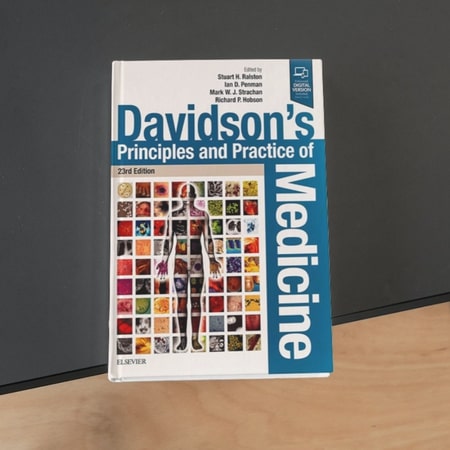
In its 24th edition, this thoroughly updated textbook describes the pathophysiology and clinical features of the most frequently encountered conditions in the major specialties of adult medicine and explains how to recognize, investigate, diagnose, and manage them.
The book takes its origins from Sir Stanley Davidson’s much-admired lecture notes and has endured because it keeps pace with how modern medicine is taught and provides a wealth of trusted information in an easy-to-read, concise, and beautifully illustrated format.
The textbook is organized into three parts. Part 1, “Fundamentals of Medicine,” provides an account of the principles of genetics, immunology, infectious diseases, population health, oncology, and pain management, along with a discussion of the core principles behind clinical decision-making and good prescribing.
Part 2, “Emergency and Critical Care Medicine,” covers medical emergencies in poisoning, envenomation, and medicine in austere environments, as well as common presentations in acute medicine and the recognition and management of the critically ill.
Part 3, “Clinical Medicine,” covers the major medical specialties, each thoroughly revised and brought fully up to date. A new section on COVID-19 has been added, and the impact of this infection is described throughout the book.
The text is extensively illustrated, with over 1000 diagrams, clinical photographs, and radiology and pathology images. The global perspective is enhanced by an International Advisory Board of experts from 11 countries and leading authors from around the world.
Davidson also includes a number of features that aid in learning and understanding the material. Clinical Examination overviews are extended and updated to summarize the main elements of each system. Presenting Problems sections provide a clear pathway for the assessment of and approach to the most common complaints in each specialty.
Practice Point summaries detail the practical skills that medical students and junior doctors must acquire. Emergency boxes emphasize the core knowledge needed to manage acutely ill patients. In Old Age, In Pregnancy, and In Adolescence, boxes highlight differences in the practice of medicine in these patient groups and illustrate the interfaces between medical, obstetric, and pediatric services.
The complete, downloadable eBook version is included with your (print copy) purchase for easy access on your portable device anytime, anywhere. Now enhanced with new interactive self-assessment material – over 150 Questions and Answers test your understanding of chapter key points and aid efficient exam preparation.
6. “Fuster and Hurst’s The Heart”
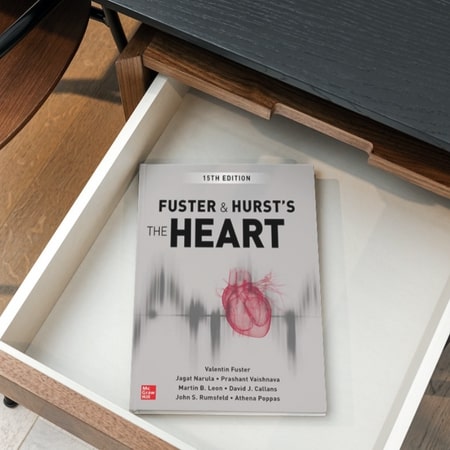
Fuster and Hurst’s The Heart is a landmark text that belongs in the hands of every cardiologist and internist, and it has been fully updated and reorganized in its fifteenth edition to make it more patient-centric than ever.
World-famous for its authority and clinical relevance, this trusted classic offers a solid foundation in cardiovascular medicine and complete coverage of all major cardiovascular topics, making it an indispensable resource for cardiologists, fellows, and interns.
The content is ordered in a more methodical pattern, from mechanism to management, with a greater focus on the practicalities of patient care. Reflecting the latest technical, therapeutic, and clinical advances, Fuster and Hurst’s The Heart provides invaluable concise summaries of major new trials and guidelines.
This fifteenth edition of Fuster and Hurst’s The Heart features authoritative coverage and unmatched utility, with central illustrations, a new section on cardiovascular critical care, and a new chapter on “Cardiovascular Disease and COVID-19.”
The book also includes chapter summaries and ACC/AHA/ESC guidelines in all chapters, along with 1,200+ photos and illustrations. The book is organized into sections that include Risk Factors for Cardiovascular Disease, Atherosclerosis and Coronary Heart Disease, Diseases of the Great Vessels and Peripheral Vessels, Valvular Heart Disease, Rhythm and Conduction Abnormalities, Heart Failure, Diseases of the Pericardium, Cardiopulmonary Disease, Critical Cardiovascular Care, Adult Congenital Heart Disease, and Special Populations and Topics in Cardiovascular Disease.
With its authoritative coverage, practical focus, and comprehensive scope, Fuster and Hurst’s The Heart is an essential resource for anyone involved in the field of cardiology.
7. “The Merck Manual of Diagnosis and Therapy”
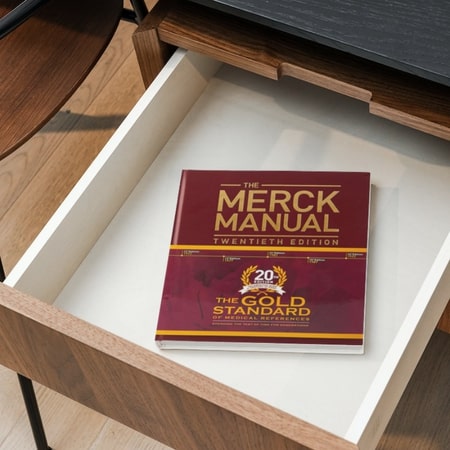
The Merck Manual of Diagnosis and Therapy is the world’s most widely used medical reference, now in its 20th edition, with 40% new and revised content. This comprehensive guide is packed with essential information on diagnosing and treating medical disorders, written by a team of medical experts.
With a new larger trim size, 36 new chapters, more than 200 new tables, and numerous new figures, this edition is thoroughly updated and thoughtfully expanded to provide the most up-to-date information in the field. Intended for everyday use by health care professionals, this book is an essential resource for delivering the best care to patients.
The new Merck Manual of Diagnosis and Therapy 20th edition offers revised and expanded Cardiovascular, Genitourinary, Gynecologic, Neurologic, Pregnancy, Infants and Children, and Pediatrics and Trauma chapters, along with Key Points that summarize the facts at-a-glance and Pearls and Pitfalls that highlight noteworthy medical information and areas of caution.
The book also includes a 16-page full-color insert that aids visual recognition of skin, eye, and oral disorders. Whether you’re a medical student, resident, practicing physician, nurse, or allied health professional, the new Merck Manual of Diagnosis and Therapy 20th edition is a must-have reference for delivering high-quality care to patients.
How to Pick the Best Internal Medicine Textbook
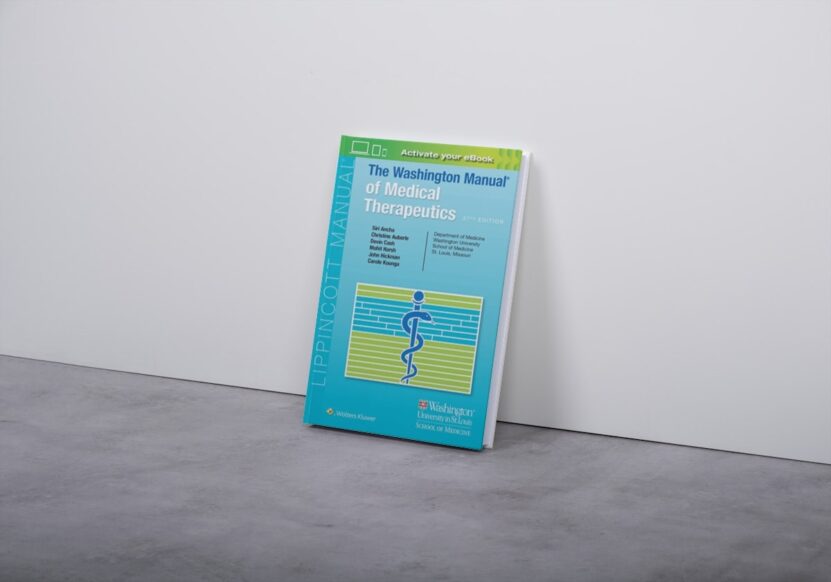
As a medical student, resident, or practicing physician, selecting the best internal medicine textbook is essential for your success in clinical practice. With so many options available, it can be overwhelming to decide which textbook to choose. Here are some key factors to consider when selecting the best internal medicine textbook for your needs.
Consider Your Learning Style
First and foremost, consider your learning style. Do you prefer a textbook that is concise and straightforward, or do you want one with in-depth information and detailed explanations? Some textbooks are written in a conversational tone, while others are more technical.
Consider what type of learning style suits you best, and select a textbook that caters to that style. Additionally, some textbooks come with additional online resources, such as quizzes, case studies, and videos, which can enhance your learning experience.
Check the Book’s Authoritativeness
One of the most important factors to consider when selecting an internal medicine textbook is the book’s authoritativeness. Ensure that the textbook is written by reputable authors who are experts in their fields.
Look for a textbook that is recognized by healthcare professionals worldwide as the leading authority on applied pathophysiology and clinical medicine. You want a book that provides comprehensive, accurate, and essential coverage of the pathogenesis, diagnosis, and treatment of disease.
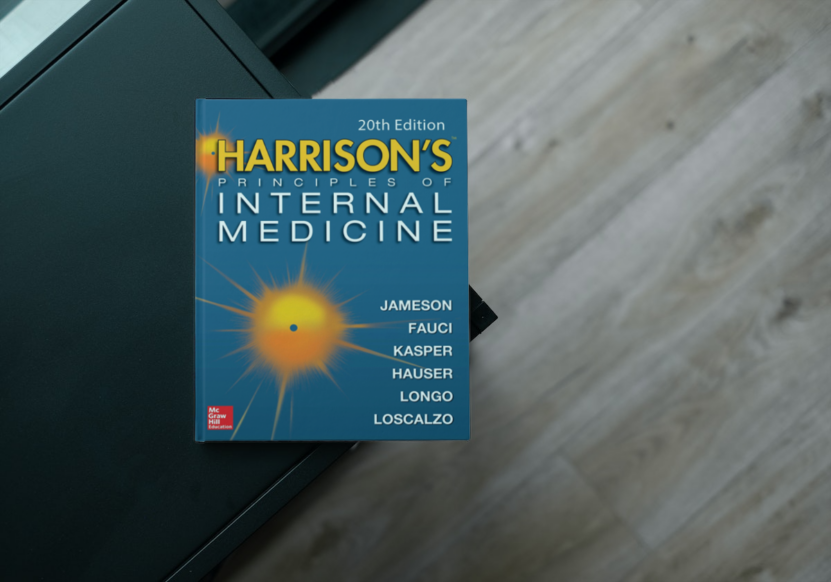
Check the Content of the Textbook
When selecting an internal medicine textbook, it’s important to consider the content of the book. Look for a textbook that covers a broad range of diseases and disorders, including rare conditions. The textbook should provide clear, concise schemas that facilitate the generation of differential diagnoses to reason efficiently through complex real-world clinical cases.
Check if the book provides comprehensive descriptions of the pathophysiology and etiology of signs and symptoms, which are covered through expert guidance and linked to disease-specific chapters that follow.
Check the Book’s Visual Aids
Another important factor to consider is the book’s visual aids. Check if the book provides excellent and extensive visual support, including radiographs, clinical photos, schematics, and high-quality drawings.
Visual aids can help you understand and remember complex concepts more easily. Check if the textbook provides practical clinical decision trees and algorithms and if it has organ/system-specific sections with clinically relevant pathophysiology and practical clinical advice on the approach to the patient.
Check the Book’s Update History
Finally, consider the book’s updated history. Medicine is a constantly evolving field, and new information and treatments are constantly emerging. Look for a textbook that is regularly updated with timely new chapters and essential updates across the spectrum of internal medicine. Check the date of the most recent edition and ensure that it includes updates on the latest clinical trial results and recommended guidelines.
If you liked this text you might want to read it too Best Mycology Textbooks.
Final Words
The best internal medicine textbooks provide comprehensive coverage of the pathogenesis, diagnosis, and treatment of diseases. They are written and edited by world-renowned experts in their respective fields, providing accurate and up-to-date information on the most current medical practices.
Whether you are a medical student, resident, or practicing physician, having access to the right internal medicine textbook can significantly improve your knowledge and expertise.

